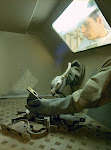I spent this week looking at a new phone system for the
business and given the rapid changes in the telecommunications industry, there
is a lot to consider. One development that has taken ten years to become a
reliable option is Voice Over Internet
Protocol or VoIP. Under this technology, phone calls are made using an Internet
or private network connection. As I was considering changing my well-seasoned,
hardwired system to this more flexible and less expensive alternative, I was
confronted with what I should do with the fax line. I felt very uncomfortable
in pulling the plug on this old-school warrior. It wasn’t long ago that the fax
line was the lifeline for many construction-related businesses. Although today
it is used primarily as a clearing house for discounted vacations, everyone
still prints their fax number on their business cards. This made me wonder why
we have become so attached to old technologies and habits when they no longer
serve us and ponder other opportunities for change in the construction
industry.
It wasn’t long ago that the fax machine was the best thing
since sliced bread for business. Instead of using the US mail system, we could
now receive bid invites, send out bids and communications, and even sign
contracts via this wonderful machine. Written communication with the fax
machine was virtually instantaneous, or at least much faster than the US mail
or FedEx options. With the universal usage of e-mail, however, the trusty fax
machine has been retired to the same pasture as the buggy whip and video rental
stores. Why would you mess with a fax when you can command the transfer of
information, documents, and pictures right from your desktop? What are some of
the other technologies that are rendering our current practices obsolete?
It is amazing how bogged down our industry was in managing
the masses of paperwork in the past. Now, cloud-based applications and online
use of construction data has revolutionized how we communicate in the industry.
The growth of online plan rooms to publicize projects that are bidding and to
relay the construction documents and addenda has cut costs, increased exposure,
and reduced the time it takes to bid a job. Programs like Textura that provide
an array of programs that facilitate project communication, subcontractor
qualification process, and invoice payment do a great deal to streamline what
was once a cumbersome process of communication. And online banking has
contributed immensely to the faster flow of funds to all parties. For those of
us who have embraced these technological tools, life is so much more productive
and easier to manage.
Building Information Modeling (BIM) has been a major
breakthrough for how projects are designed and constructed. In the past,
architects, contractors, and subcontractors worked as separate entities, only
coming together when the building was being constructed. With BIM as the
platform, now the design and construction team can work together more
effectively to design, estimate, construct, and problem solve. This technology
is creating an entirely new way of looking at the construction process. The
benefits are lower costs, faster delivery, and fewer errors.
Advances in technological hardware have changed the way we
work in construction. Jobsite computer systems and tablet computers enable the
team to be equipped with the latest information on the project. New
developments in Google Glass and Oculus virtual reality technology will most
likely offer benefits to our current work processes. Another technology that is
quickly gaining acceptance is 3D laser scanning. Architectural and engineering
firms are using this developing technology to map out existing facilities with
incredible precision or to serve as quality control of installed elements.
Re-View has used laser mapping equipment to determine existing window sizes and
shapes in historic structures. This has enabled us to manufacture historic
window replicas with incredible precision.
What we are talking about here is changing the tools of the
trade. Just as carpenters have put down hand saws and screw drivers for power
tools, the entire industry needs to change to more powerful technological
tools. I may love my old framing hammer, but it doesn’t hold up to modern
nailers. So in that spirit, I think I’ll finally remove my fax number from my
business card.






